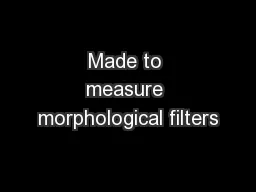

Fernand Meyer Center of mathematical morphology MinesParisTech France Non edge preserving filters The adjunction erosiondilation Openingsclosings The simplest filters Alternate sequential filters ID: 549098
Download Presentation The PPT/PDF document "Made to measure morphological filters" is the property of its rightful owner. Permission is granted to download and print the materials on this web site for personal, non-commercial use only, and to display it on your personal computer provided you do not modify the materials and that you retain all copyright notices contained in the materials. By downloading content from our website, you accept the terms of this agreement.
Slide1
Made to measure morphological filters
Fernand Meyer
Center of mathematical morphology
Mines-ParisTech
FranceSlide2
Non edge preserving filters
The adjunction erosion/dilation
Openings/closings
The simplest filters
Alternate sequential filtersSlide3
Erosions and dilations of
increasing
sizes
Slide4
Erosions of increasing size
Regional minima get larger
New maxima may appear. Most maxima vanish, others get larger. Slide5
Dilations of increasing size
New minima may appear. Most mainima vanish, others get larger.
Regional maxima get larger, some coalesce, others disappear.Slide6
Increasing erosions
Increasing dilations
Erosion = minimal value in a window
darker image
Dilation = maximal value in a window
brighter image
INCREASING WINDOW + STRONGER EFFECTSlide7
combining an
erosion
and a dilation in
sequence
, in
order
to get
openings or closings.Slide8
A dilation
Brighter
An erosion
Darker
= opening
Darker
Followed bySlide9
openings of increasing size
Each reg. min. of a large closing contains a reg. Min. of each smaller opening
Regional maxima get larger, some coalesce, others disappear.Slide10
A dilation
Brighter
An erosion
Darker
= closing
Brighter
Followed bySlide11
openings of increasing size
Regional minima get larger, some coalesce, others disappear.
Each reg. max. of a large closing contains a reg. Max. of each smaller closing Slide12
Open-close,
close-open,
Open-close-open,
close-open-close Slide13
A closing
Brighter
An opening
Darker
= morphological filter
Similar grey tone
Followed bySlide14
A closing
Brighter
An opening
Darker
= morphological filter
Similar
grey tone
Followed bySlide15
Opening followed by closing of increasing sizes
Regional minima
Regional maximaSlide16
Closing followed by opening of increasing sizes
Regional minima
Regional maximaSlide17
Opening followed by closing of increasing sizes
Closing followed by opening of increasing sizes
The two are not comparableSlide18
Open close open of increasing sizes
Close-open-close
open-close-open
Close open close of increasing sizesSlide19
Closing followed by opening followed by closing of increasing sizes
Regional minima
Regional maximaSlide20
A small closing followed by a small opening = small effects
A large closing followed by a large opening = too crude
Alternate sequential filter = sequence of increasing
pairs of an opening followed by a closingSlide21
Alternate sequential filter starting with an opening of increasing sizes
Regional minima
Regional maximaSlide22
Alternate sequential filter starting with a closing of increasing sizes
Regional minima
Regional maximaSlide23
Partial conclusion
Non edge preserving filters simplify the images but the displacement of the contours is annoying in many cases and in particular if the filter precedes image segmentation
We will now introduce
edge preserving filters
:
Razings
Floodings
Levelings